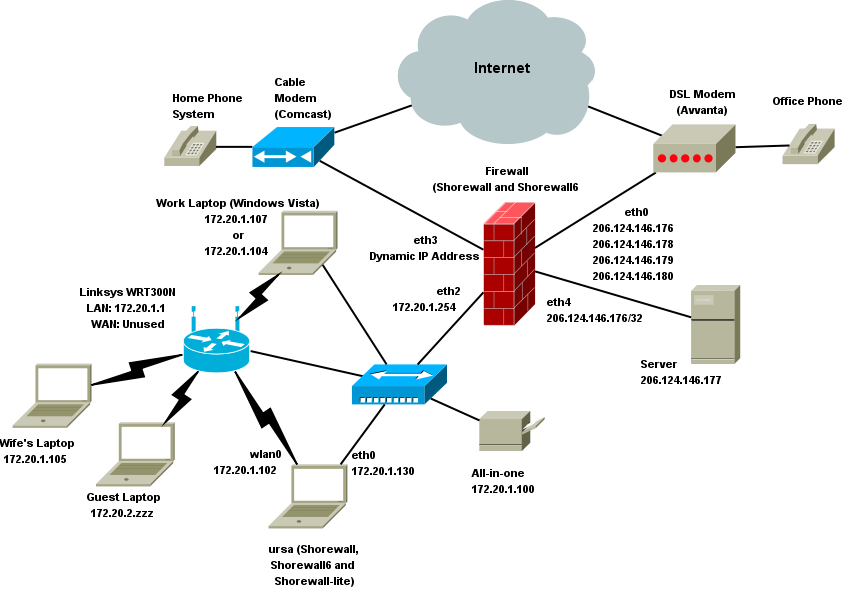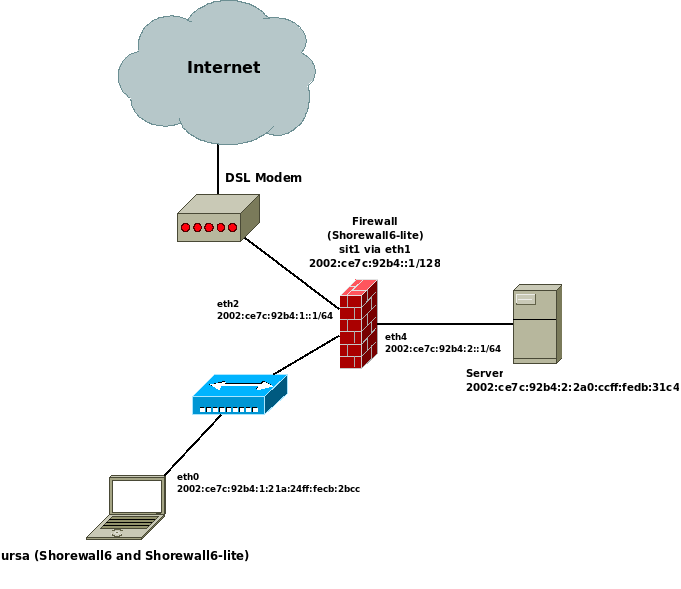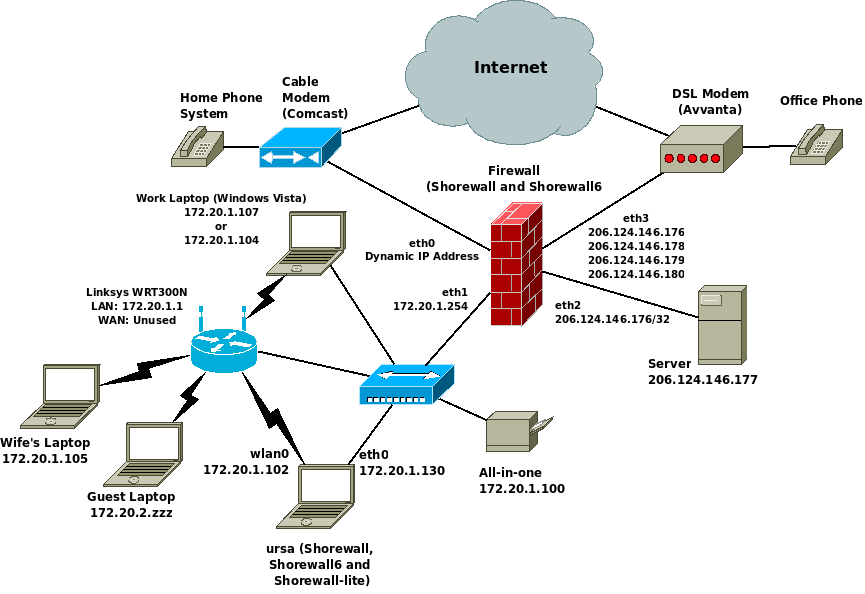- Ipv6 to ipv4 tunnel linux
- Getting your Feet Wet with IPv6, by Tom Eastep
- Configuring IPv6 using my script
- Note
- Configuring IPv6 the Debian Way
- 9.4. Setup of 6to4 tunnels
- 9.4.1. Add a 6to4 tunnel
- 9.4.1.1. Using «ip» and a dedicated tunnel device
- 9.4.1.2. Using «ifconfig» and «route» and generic tunnel device «sit0» (deprecated)
- 9.4.2. Remove a 6to4 tunnel
- 9.4.2.1. Using «ip» and a dedicated tunnel device
- 9.4.2.2. Using «ifconfig» and «route» and generic tunnel device «sit0» (deprecated)
Ipv6 to ipv4 tunnel linux
Copyright © 2003-2004, 2008, 2009, 2012 Eric de Thouars and Tom Eastep
Permission is granted to copy, distribute and/or modify this document under the terms of the GNU Free Documentation License, Version 1.2 or any later version published by the Free Software Foundation; with no Invariant Sections, with no Front-Cover, and with no Back-Cover Texts. A copy of the license is included in the section entitled “ GNU Free Documentation License ” .
Table of Contents
6to4 tunneling with Shorewall can be used to connect your IPv6 network to another IPv6 network over an IPv4 infrastructure. It can also allow you to experiment with IPv6 even if your ISP doesn’t provide IPv6 connectivity.
More information on Linux and IPv6 can be found in the Linux IPv6 HOWTO. Details on how to setup a 6to4 tunnels are described in the section Setup of 6to4 tunnels.
Getting your Feet Wet with IPv6, by Tom Eastep
6to4 tunnels provide a good way to introduce yourself to IPv6. Shorewall6 was developed on a network whose only IPv6 connectivity was an 6to4 Tunnel; that network is described in the remainder of this section. What is shown here requires Shorewall6 4.2.4 or later.
Configuring IPv6 using my script
I have created an init script to make the job of configuring your firewall for IPv6 easier.
The script is installed in /etc/init.d and configures ipv6, including a 6to4 tunnel, at boot time. Note that the script is included in the Shorewall6 distribution but is not installed in /etc/init.d by default. The RPMs from shorewall.net, install the file in the package documentation directory.
The script works on OpenSuSE 11.0 and may need modification for other distributions. On OpenSuSE, the script is installed by copying it to /etc/init.d/ then running the command ‘chkconfig —add ipv6’.
At the top of the script, you will see several variables:
- SIT — The name of the tunnel device. Usually ‘sit1’
- INTERFACES — local interfaces that you want to configure for IPv6
- ADDRESS4 — A static IPv4 address on your firewall that you want to use for the tunnel.
- SLA — The identity of the first local sub-network that you want to assign to the interfaces listed in INTERFACES. Normally one (0001).
- GATEWAY — The default IPv6 gateway. For 6to4, this is ::192.88.99.1.
Here is the file from my firewall:
SIT="sit1" ADDRESS4=206.124.146.180 INTERFACES="eth2 eth4" SLA=1 GATEWAY=::192.88.99.1
eth2 is the interface to my local network (both wired and wireless). eth4 goes to my DMZ which holds a single server. Here is a diagram of the IPv4 network:
Here is the configuration after IPv6 is configured; the part in bold font is configured by the /etc/init.d/ipv6 script.
gateway:~ # ip -6 addr ls 1: lo: mtu 16436 inet6 ::1/128 scope host valid_lft forever preferred_lft forever 1: eth1: mtu 1500 qlen 1000 inet6 fe80::202:e3ff:fe08:484c/64 scope link valid_lft forever preferred_lft forever 2: eth2: mtu 1500 qlen 1000 inet6 2002:ce7c:92b4:1::1/64 scope global valid_lft forever preferred_lft forever inet6 fe80::202:e3ff:fe08:55fa/64 scope link valid_lft forever preferred_lft forever 3: eth4: mtu 1500 qlen 1000 inet6 2002:ce7c:92b4:2::1/64 scope global valid_lft forever preferred_lft forever inet6 fe80::2a0:ccff:fed2:353a/64 scope link valid_lft forever preferred_lft forever 4: sit1@NONE: mtu 1480 inet6 ::206.124.146.180/128 scope global valid_lft forever preferred_lft forever inet6 2002:ce7c:92b4::1/128 scope global valid_lft forever preferred_lft forever gateway:~ # ip -6 route ls ::/96 via :: dev sit1 metric 256 expires 21333315sec mtu 1480 advmss 1420 hoplimit 4294967295 2002:ce7c:92b4::1 dev sit1 metric 256 expires 21333315sec mtu 1480 advmss 1420 hoplimit 4294967295 2002:ce7c:92b4:1::/64 dev eth2 metric 256 expires 21333315sec mtu 1500 advmss 1440 hoplimit 4294967295 2002:ce7c:92b4:2::/64 dev eth4 metric 256 expires 21333315sec mtu 1500 advmss 1440 hoplimit 4294967295 fe80::/64 dev eth1 metric 256 expires 20748424sec mtu 1500 advmss 1440 hoplimit 4294967295 fe80::/64 dev eth2 metric 256 expires 20748431sec mtu 1500 advmss 1440 hoplimit 4294967295 fe80::/64 dev eth4 metric 256 expires 20748431sec mtu 1500 advmss 1440 hoplimit 4294967295 fe80::/64 dev sit1 metric 256 expires 21333315sec mtu 1480 advmss 1420 hoplimit 4294967295 default via ::192.88.99.1 dev sit1 metric 1 expires 21333315sec mtu 1480 advmss 1420 hoplimit 4294967295 gateway:~ #
You will notice that sit1, eth2 and eth4 each have an IPv6 address beginning with 2002: — All 6to4 IPv6 addresses have that in their most significant 16 bits. The next 32-bits (ce7c:92b4) encode the IPv4 ADDRESS (206.124.146.180). So once you start the 6to4 tunnel, you are the proud owner of 2 80 IPv6 addresses! In the case shown here, 2002:ce7c:92b4::/48. The SLA is used to assign each interface in INTERFACES, a subnet of 2 64 addresses; in the case of eth2, 2002:ce7c:92b4:1::/64.
I run radvd on the firewall to allow hosts conntected to eth2 and eth4 to automatically perform their own IPv6 configuration. Here is my /etc/radvd.conf file:
interface eth2 < AdvSendAdvert on; MinRtrAdvInterval 3; MaxRtrAdvInterval 10; prefix 2002:ce7c:92b4:1::/64 < AdvOnLink on; AdvAutonomous on; AdvRouterAddr off; >; RDNSS 2002:ce7c:92b4:2:2a0:ccff:fedb:31c4 < AdvRDNSSOpen on; AdvRDNSSPreference 2; >; >; interface eth4 < AdvSendAdvert on; MinRtrAdvInterval 3; MaxRtrAdvInterval 10; prefix 2002:ce7c:92b4:2::/64 < AdvOnLink on; AdvAutonomous on; AdvRouterAddr off; >; RDNSS 2002:ce7c:92b4:2:2a0:ccff:fedb:31c4 < AdvRDNSSOpen on; AdvRDNSSPreference 2; >; >;
Note
radvd terminates immediately if IPv6 forwarding is not enabled. So it is a good idea to include this in /etc/sysctl.conf :
net.ipv6.conf.all.forwarding = 1
That way, if radvd starts before Shorewall6, it will continue to run.
An alternative is to modify /etc/init.d/radvd so that radvd starts after Shorewall6:
Here is the automatic IPv6 configuration on my server attached to eth4:
webadmin@lists:~/ftpsite/contrib/IPv6> /sbin/ip -6 addr ls 1: lo: mtu 16436 inet6 ::1/128 scope host valid_lft forever preferred_lft forever 2: eth2: mtu 1500 qlen 1000 inet6 2002:ce7c:92b4:2:2a0:ccff:fedb:31c4/64 scope global dynamic valid_lft 2591995sec preferred_lft 604795sec inet6 fe80::2a0:ccff:fedb:31c4/64 scope link valid_lft forever preferred_lft forever webadmin@lists:~/ftpsite/contrib/IPv6> /sbin/ip -6 route ls 2002:ce7c:92b4:2::/64 dev eth2 proto kernel metric 256 expires 2592161sec mtu 1500 advmss 1440 hoplimit 4294967295 fe80::/64 dev eth2 metric 256 expires 20746963sec mtu 1500 advmss 1440 hoplimit 4294967295 fe80::/64 dev ifb0 metric 256 expires 20746985sec mtu 1500 advmss 1440 hoplimit 4294967295 default via fe80::2a0:ccff:fed2:353a dev eth2 proto kernel metric 1024 expires 29sec mtu 1500 advmss 1440 hoplimit 64 webadmin@lists:~/ftpsite/contrib/IPv6>
You will note that the public IPv6 address of eth2 (2002:ce7c:92b4:2:2a0:ccff:fedb:31c4) was formed by concatenating the prefix for eth2 shown in radvd.conf (2002:ce7c:92b4:2) and the lower 64 bits of the link level address of eth2 (2a0:ccff:fedb:31c4). You will also notice that the address 2002:ce7c:92b4:2:2a0:ccff:fedb:31c4 appears in the RDNSS clauses in radvd.conf; that causes my server to be automatically configured as a DNS server.
The default route is described using the link level address of eth2 on the firewall (fe80::2a0:ccff:fed2:353a).
ursa:~ # ip -6 addr ls dev eth0 3: eth0: mtu 1500 qlen 1000 inet6 2002:ce7c:92b4:1:21a:24ff:fecb:2bcc/64 scope global dynamic valid_lft 2591996sec preferred_lft 604796sec inet6 fe80::21a:73ff:fedb:8c35/64 scope link valid_lft forever preferred_lft forever ursa:~ # ip -6 route ls dev eth0 2002:ce7c:92b4:1::/64 proto kernel metric 256 expires 2592160sec mtu 1500 advmss 1440 hoplimit 4294967295 fe80::/64 metric 256 expires 21314573sec mtu 1500 advmss 1440 hoplimit 4294967295 default via fe80::202:e3ff:fe08:55fa proto kernel metric 1024 expires 28sec mtu 1500 advmss 1440 hoplimit 64 ursa:~ #
Here is the resulting simple IPv6 Network:
Configuring IPv6 the Debian Way
In May 2009, I rebuilt the above firewall using Debian GNU/Linux and decided to configure IPv6 using the /etc/network/interfaces file.
When I installed Debian Lenny on the system, the network interfaces were reunmbered as follows:
Table 1. Interface Renaming
| Old Configuration | New Configuration |
| eth0 (Avvanta Interface) | eth3 |
| eth3 (Comcast Interface) | eth0 |
| eth2 (Local Interface) | eth1 |
| eth4 (DMZ Interface) | eth2 |
So the IPv4 network was transformed to this:
To implement the same IPv6 network as described above, I used this /etc/shorewall/interfaces file:
auto lo iface lo inet loopback auto eth0 iface eth0 inet dhcp hwaddress ether 00:11:85:89:da:9b auto eth1 iface eth1 inet static address 172.20.1.254 netmask 255.255.255.0 network 172.20.1.0 broadcast 172.20.1.255 iface eth1 inet6 static address 2002:ce7c:92b4:1::1 netmask 64 auto eth2 iface eth2 inet static address 206.124.146.176 netmask 255.255.255.255 up ip route add 206.124.146.177/32 dev eth2 iface eth2 inet6 static address 2002:ce7c:92b4:2::1 netmask 64 auto eth3 eth3:0 eth3:1 eth3:2 iface eth3 inet static address 206.124.146.176 netmask 255.255.255.0 network 206.124.146.0 broadcast 206.124.146.255 iface eth3:0 inet static address 206.124.146.178 netmask 255.255.255.0 broadcast 206.124.146.255 iface eth3:1 inet static address 206.124.146.179 netmask 255.255.255.0 broadcast 206.124.146.255 iface eth3:2 inet static address 206.124.146.180 netmask 255.255.255.0 broadcast 206.124.146.255 auto sit1 iface sit1 inet6 v4tunnel address 2002:ce7c:92b4::1 netmask 64 endpoint 192.88.99.1 local 206.124.146.180 gateway ::192.88.99.1 ttl 64 post-up echo 1 > /proc/sys/net/ipv6/conf/all/forwarding
That file produces the following IPv6 network.
9.4. Setup of 6to4 tunnels
Pay attention that the support of 6to4 tunnels currently lacks on vanilla kernel series 2.2.x (see systemcheck/kernel for more information). Also note that that the prefix length for a 6to4 address is 16 because of from network point of view, all other 6to4 enabled hosts are on the same layer 2.
9.4.1. Add a 6to4 tunnel
First, you have to calculate your 6to4 prefix using your local assigned global routable IPv4 address (if your host has no global routable IPv4 address, in special cases NAT on border gateways is possible):
Assuming your IPv4 address is
the generated 6to4 prefix will be
Local 6to4 gateways should always assigned the manual suffix «::1», therefore your local 6to4 address will be
Use e.g. following for automatic generation:
ipv4=»1.2.3.4″; printf «2002:%02x%02x:%02x%02x::1» `echo $ipv4 | tr «.» » «`
There are two ways possible to setup 6to4 tunneling now.
9.4.1.1. Using «ip» and a dedicated tunnel device
This is now the recommended way (a TTL must be specified because the default value is 0).
Create a new tunnel device
# /sbin/ip tunnel add tun6to4 mode sit ttl remote any local
# /sbin/ip link set dev tun6to4 up
Add local 6to4 address to interface (note: prefix length 16 is imporant!)
# /sbin/ip -6 addr add /16 dev tun6to4
Add (default) route to the global IPv6 network using the all-6to4-routers IPv4 anycast address
# /sbin/ip -6 route add 2000::/3 via ::192.88.99.1 dev tun6to4 metric 1
9.4.1.2. Using «ifconfig» and «route» and generic tunnel device «sit0» (deprecated)
This is now deprecated because using the generic tunnel device sit0 doesn’t let specify filtering per device.
Bring generic tunnel interface sit0 up
Add local 6to4 address to interface
Add (default) route to the global IPv6 network using the all-6to4-relays IPv4 anycast address
# /sbin/route -A inet6 add 2000::/3 gw ::192.88.99.1 dev sit0
9.4.2. Remove a 6to4 tunnel
9.4.2.1. Using «ip» and a dedicated tunnel device
Remove all routes through this dedicated tunnel device
# /sbin/ip -6 route flush dev tun6to4
# /sbin/ip link set dev tun6to4 down
Remove created tunnel device
# /sbin/ip tunnel del tun6to4
9.4.2.2. Using «ifconfig» and «route» and generic tunnel device «sit0» (deprecated)
Remove (default) route through the 6to4 tunnel interface
# /sbin/route -A inet6 del 2000::/3 gw ::192.88.99.1 dev sit0
Remove local 6to4 address to interface
Shut down generic tunnel device (take care about this, perhaps it’s still in use. )




